Day 2 of our three-day Winter, Broads & Brecks tour today. It was a cloudy start, with some brighter intervals through the day, with a moderate SW wind. With one eye on the forecast for tomorrow, we decided to spend the day in North Norfolk today.
There had been no reports of the Waxwing yesterday at Salthouse, but we heard a suggestion it was possibly still there. We went to look anyway, first thing, but there was no sign of it in the churchyard, where it had been, and no berries left on its favoured hedge. We scanned the trees in the village, and found several Greenfinches and Starlings and House Sparrows in the hedge. Rather than waste any more time, not knowing if it was even still here, we decided to move on. We had a lot of other things we wanted to try to squeeze in today.
When we got to Wells, the Rough-legged Buzzard was perched more obligingly on its usual bush. We got out of the minibus an trained the scopes on it. We could see its very pale head, contrasting with its dark blackish belly patch.
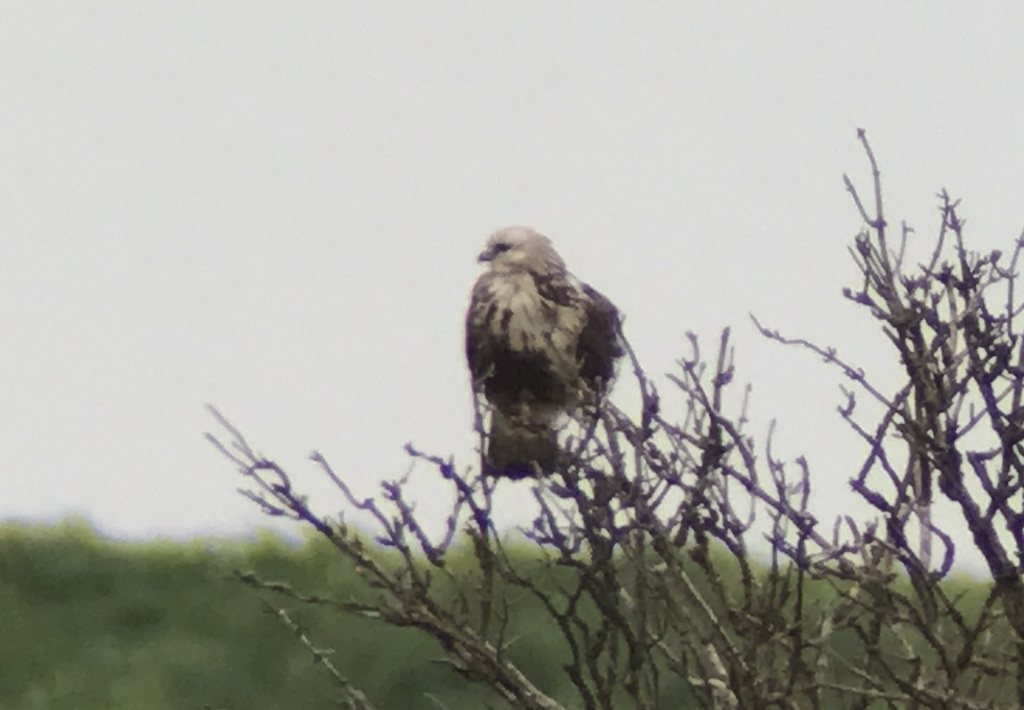
There were lots of Lapwings and gulls in the ploughed field in front of the layby, including several different ages of Herring Gull which we took a closer look at (by popular request!). A Sparrowhawk flew past, flushing everything, and disappeared behind the hedge.
After having a good look at the Rough-legged Buzzard, we carried on round to Holkham, and parked at the top of Lady Anne’s Drive. There were lots of ducks around the pools out on the grazing marsh – lots of Wigeon, a few Shoveler and one or two Teal. As well as several Redshanks, there were two Ruff feeding out on the grass quite close to the fence, giving a good comparison. We could see the distinctive scaly appearance caused by the pale fringes to the upperparts feathers on the Ruff.

As we walked up towards The Lookout cafe, we could see several Grey Partridges feeding on the grass. A nice orange-faced male was very close to the fence, and as we walked up it stopped feeding and lifted its head up, showing off its dark, kidney-shaped belly patch. A second male was feeding with a duller, browner female a little further back.

Scanning from the Lookout, while some of the group went inside to use the facilities, someone standing there mentioned that he had found what he thought was a Peregrine way out, down in the grass. Looking through his scope, it was indeed a Peregrine, an adult. We trained our scopes on it too – we could just see its head and shoulders, its dark cap extending down in a broad, rounded moustache. Two Rock Pipits flew in for a quick bathe on the pools before flying back out over the pines. We could see small numbers of Brent Geese dropping in further back too.
Heading out towards the beach, we met someone who had been out with us yesterday who told us that the Shorelarks were not in the cordon this morning. Armed with that knowledge, we thought we would check the saltmarsh west of the Gap first instead. As we walked out, several small flocks of Linnets flew over along with one or two Skylarks. But there were two dogs having a high old time, running backwards and forwards around over the whole saltmarsh that side, their owners miles away and oblivious, and needless to say there were no birds left there.
As we turned to walk across the Gap, we saw a large flock of Snow Buntings in the distance. They flew up from the saltmarsh off towards the cordon, over the dunes and dropped down towards the beach. A small group of Skylarks flew in and landed on the shingle, where we might have hoped the Shorelarks would drop in instead!
We walked through the back of the dunes the other side and cut through a gap to the beach. The first thing we saw was a large flock of scoter gathered like a black oil slick just offshore. There were hundreds of Common Scoter, lots of pale-cheeked browner females accompanied by a good number of plainer, blacker drakes. Looking with the scopes, we could see several Velvet Scoters in with them, but they were very hard to pick out, not helped by the fact that the flock was constantly on the move and diving.
Most of the Velvet Scoters were females or young males, but we did find one adult male with bright yellow edges to the bill and white tick mark surrounding the eye. Eventually everyone got onto at least one of the Velvet Scoters, though it took some time to get your eye in, despite the fact that this group was not far offshore. A larger group of Common Scoter was much further out – we didn’t even attempt to try to find the Velvet Scoters in that group! There were a few Red-breasted Mergansers mixed in with the scoters too.
When we finally took our attention off the rafts of seaduck, we noticed a large flock of Snow Buntings had appeared out on the sand. We got them in the scope, and counted 48 of them. They were flushed by two people walking along the beach and flew round, over the dunes behind us and then almost overhead, before landed again on the beach, much closer to us. We had a great view of them now.
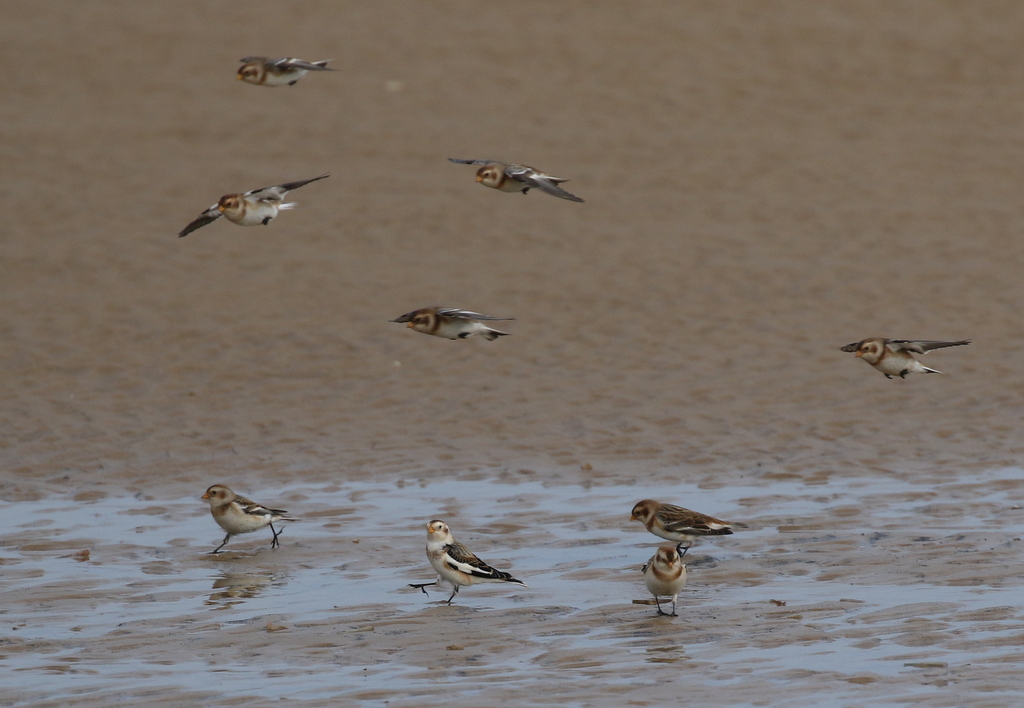
Further over, along the beach to the east of us, we could see lots of birds on the sandbank beyond the channel, presumably where there was less disturbance. Through the scopes, we could see several silvery-grey Sanderlings running in and out of the Oystercatchers and gulls. A few Cormorants were drying their wings further back.
When we walked along the beach and cut back in towards the cordon, we found that the Shorelarks had now reappeared. We scanned from up in the dunes first, and could see them feeding down on the saltmarsh inside the fence. They were much closer from round the other side, and we had a much better view of them. Their canary yellow faces caught the sunshine when they lifted their heads.

We walked back, and stopped for lunch in The Lookout. As we made our way back to the minibus afterwards, a flock of Pink-footed Geese flew over and dropped down towards the grazing marshes out in the middle, the only ones we saw here today.
A little further on, we stopped to scan the grazing marshes again. The first thing we found was a group of White-fronted Geese out on the grass. As we scanned across, we counted at least fifty of them, the white surrounds to the base of their bills (the white ‘front’) showing clearly as they lifted their heads.
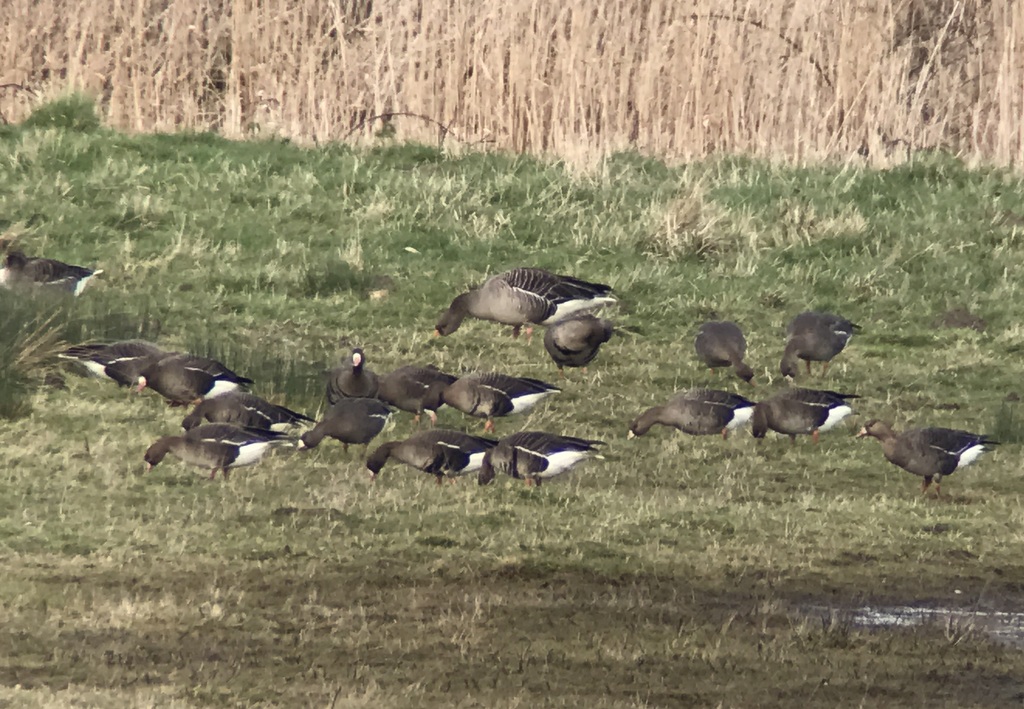
A Great White Egret feeding in one of the rushy pools stood out a mile off, being very large and very white. A second flew across over the back and landed beyond the reeds. When another white bird flew out from behind the trees, it immediately looked different, its head and neck held extended out in front as it flew. It was a Spoonbill – the first two birds have returned already for the summer just in the last couple of days, so it was great to see one today. Spring must be on its way! It landed on the largest of the pools, and we got it in the scope, watching it feeding, sweeping its bill from side to side as it walked round through the shallow water.
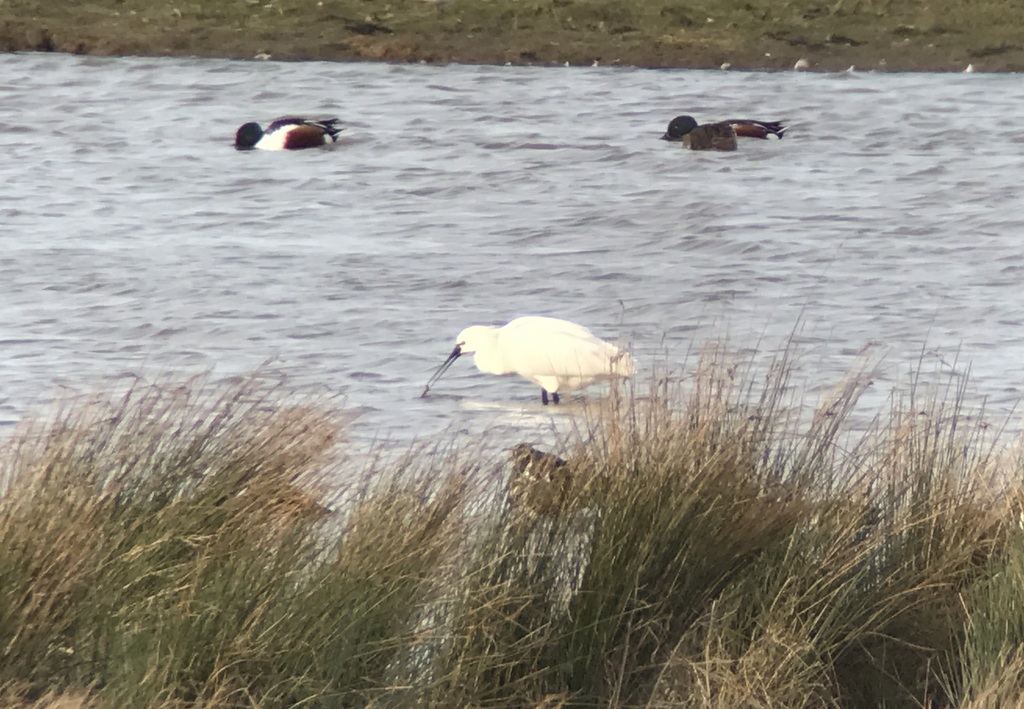
Several Marsh Harriers were flying round over the grazing marshes and we picked out a Red Kite distantly over the trees too. Then a Hen Harrier appeared, a ringtail, smaller and lighter built and flashing the white square at the base of its tail. It flew low west over the grazing marsh, quartering and disappeared round behind the trees.
Back in the minibus, we drove west inland next, over to Sedgeford. As we pulled up, we could see three people looking intently at the muck heap right by the main road. We quickly got out and sure enough, the Eastern Yellow Wagtail was right there. If only it was always so easy! We watched it feeding on the mud around the base of the heap. It has been a bit more erratic in its appearances in the last few days, so it was great to find it so obliging.

There were lots of gulls loafing in the ploughed field opposite. When a large group circled up and overhead, we looked up to see a Mediterranean Gull in with them, its white wingtips translucent against the blue sky. It was rather hard to pick out though, and despite looking through the flock out in the field, we couldn’t find another one with all the Black-headed, Common and Herring Gulls there. Thankfully, numbers are already starting to increase now and we would see some more later.
We made our way down to the coast at Thornham next. As we drove down the road to the harbour, we could see ten small birds circling over the narrow strip of saltmarsh right beside it – the Twite. They clearly wanted to come in to land, but there were too many people walking down the road and they wouldn’t settle. They circled round several times, then flew back to the old coal barn and landed on the roof. We piled out, and had a great view of them, the sunshine catching their yellow bills and burnt orange breasts.
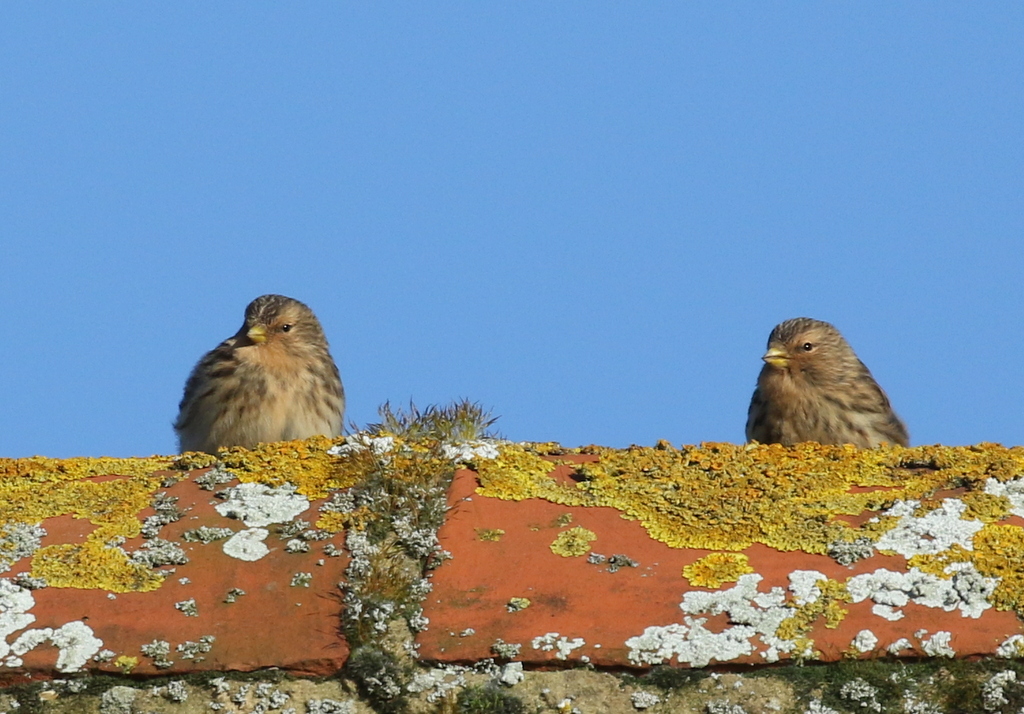
When the Twite flew again, they dropped down and landed on the saltmarsh, to feed on the seed heads. Something spooked them again, and seven flew straight back up to the barn roof, but three Twite remained down on the saltmarsh. One perched up nicely and we could see it was sporting a set of coloured rings – this bird wintered at Thornham last winter too, and was originally ringed in Derbyshire in May 2018.
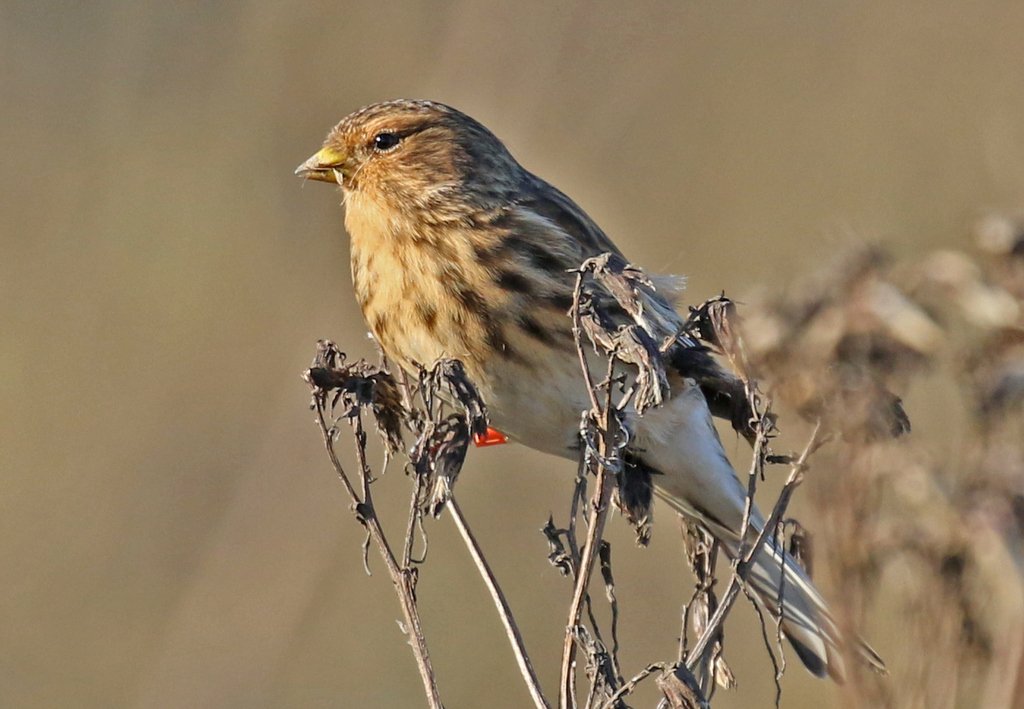
There were no different waders in the harbour channel, so we got back in the minibus and drove over to Titchwell next. A quick check in at the Visitor Centre confirmed that one of the Woodcock was in situ again, so we made our way straight round to look for it. A large crowd was gathered on the narrow boardwalk, and we had to wait a few minutes until we eventually got to a place where we could see it. It was then fill the frame views in the scope, albeit of just its head and the top of its body where it was hiding down amongst the moss covered branches.

Continuing round, back to the main path, we had a quick look for Water Rails in the ditch. There was no sign of any, but we did see a Chiffchaff flitting around in the bushes just below the pass. As we walked on, a couple of Marsh Harriers were hanging in the air, up over the back of the reedbed. Several Common Pochard and Tufted Duck were in amongst the Greylags and Canada Geese on the reedbed pool.
Hundreds of Golden Plovers and Lapwings were whirling round over Freshmarsh, as we walked out, gradually landing back again. The water level has finally gone down now, and there are more islands exposed, much to the appreciation of the waders. the nearest ones were now covered in the Golden Plover. There were lots of Avocets too, with numbers steadily climbing again now with one eye on spring already, up to seventy today. A single Black-tailed Godwit was asleep in the middle of them.
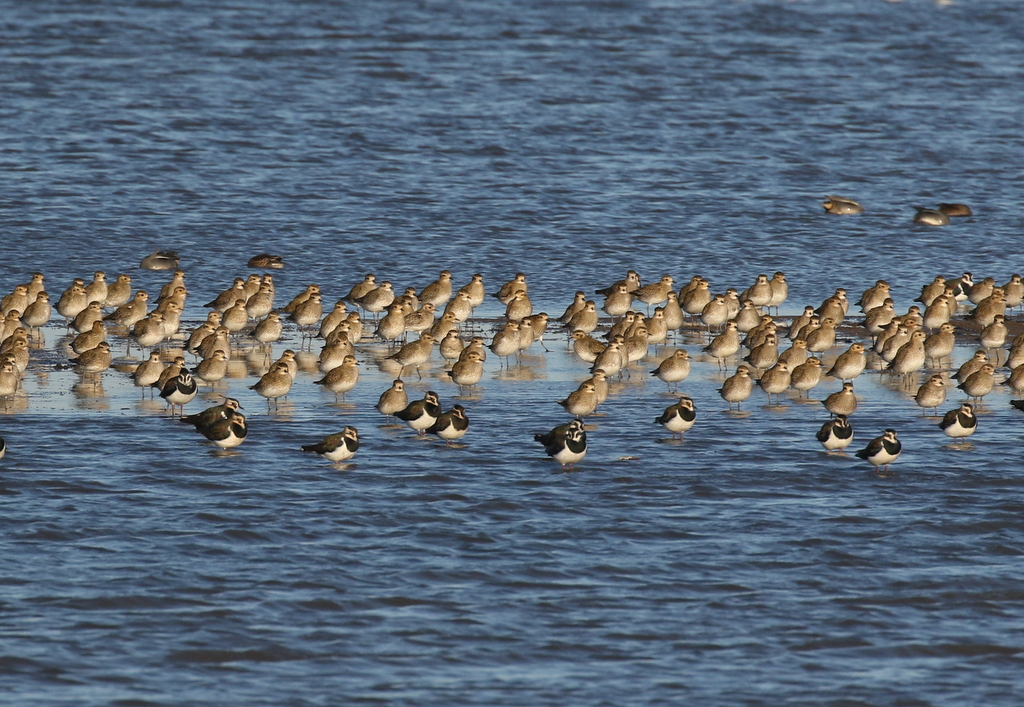
There were lots of gulls on here too – they seem to appreciate the shallower water. They were mostly Black-headed Gulls, but looking through them, we found several Mediterranean Gulls too. We got two adults in scope, one already getting some of its black hood. There were lots of Teal gathered round the edges of the Freshmarsh, with the drakes looking stunning now, particularly in the late afternoon sun.
We had a quick look in Parrinder Hide, but there was no sign of any Water Pipit around the islands or along the reedy edges below the bank, so we carried on out towards the beach. As we passed the Volunteer Marsh, we could see the tide was now comng in quickly. The small channel below the bank was filling fast, and the Redshanks had climbed up the bank beyond. Looking down the wider channel at the far side, we could see several Curlew, more Redshanks, a single Grey Plover and a couple of Knot.
The Tidal Pool has been really good for waders, since it has returned to being tidal again. We scanned the SE corner first, but there was no sign of any different shanks down there now. A little further along, there were two Black tailed Godwits feeding close to the path. The spit further back was full of roosting waders, mostly Bar-tailed Godwits mixed with a smaller number of Grey Plover, Knot and Dunlin. More were flying in all the time, coming in off beach to roost here over high tide. There were lots of Oystercatchers too, roosting higher up on the island, and a scattering of Turnstones along the far edge.
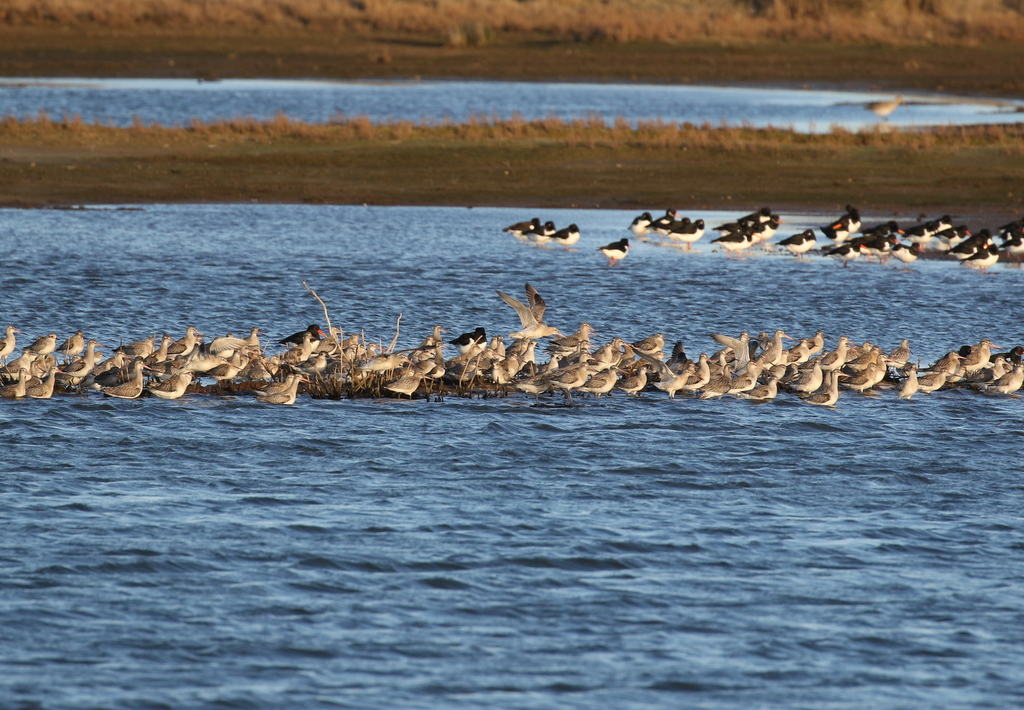
Beyond waders, there were several Pintail, including several smart drakes, busy upending with the Mallards out on the water. We could see their long, pin-shaped central tail fathers. Four Little Grebes were hiding along the bank.
We had a quick look out at the sea. The tide was in now and the beach was covered. There were a few Goldeneye out on the water, closer in, and one or two Great Crested Grebes, but most of the birds were much further out. A drake Eider flew in and landed on the sea, and another group of eight flew past much further out, along the horizon. We picked out a distant Red-throated Diver too, but it dived before anyone could get onto it and we couldn’t relocate it.
As we started to walk back, we stopped to scan the far corner of the Tidal Pool again. This time we found a Spotted Redshank, tucked in on the edge of one of the small islands at the back, roosting.
We stopped again in Parrinder Hide. We could see the Marsh Harriers gathering out over the reedbed. A distant Barn Owl appeared, flying through the back of the reedbed and disappearing round towards the church. A few Pied Wagtails started to drop in to the islands ahead of going to roost in the reedbed. A Water Pipit appeared too, perched on the fence. We got it in the scope, before it flew further along to a post, but it didn’t linger and then flew off shortly after.
The light was starting to go now, so we walked back. There was a stunning moon, rsiing over the bank at the back, and we stopped for a quick look at it in the scope. It is not just the birds which are worth stopping to look at! The Marsh Harriers were still coming in, and we counted at least 15 in the air together as we passed the reedbed. Lots of Little Egrets were coming in to roost too. A Barn Owl was perched on a post at the back, before taking off and flying over the bank.
It was time to head for home. We had enjoyed a really productive day and made the most of the good weather ahead of tomorrow.
















